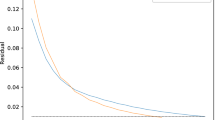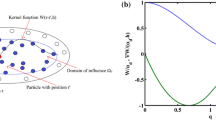Abstract
Incompressible SPH (ISPH) is a promising concept for the pressure computation in SPH. It works with large timesteps and the underlying pressure Poisson equation (PPE) can be solved very efficiently. Still, various aspects of current ISPH formulations can be optimized. This paper discusses issues of the two standard source terms that are typically employed in PPEs, i.e., density invariance (DI) and velocity divergence (VD). We show that the DI source term suffers from significant artificial viscosity, while the VD source term suffers from particle disorder and volume loss. As a conclusion of these findings, we propose a novel source term handling. A first PPE is solved with the VD source term to compute a divergence-free velocity field with minimized artificial viscosity. To address the resulting volume error and particle disorder, a second PPE is solved to improve the sampling quality. The result of the second PPE is used for a particle shift (PS) only. The divergence-free velocity field—computed from the first PPE—is not changed, but only resampled at the updated particle positions. Thus, the proposed source term handling incorporates velocity divergence and particle shift (VD + PS). The proposed VD + PS variant does not only improve the quality of the computed velocity field, but also accelerates the performance of the ISPH pressure computation. This is illustrated for IISPH—a recent ISPH implementation—where a performance gain factor of 1.6 could be achieved.













Similar content being viewed by others
Explore related subjects
Discover the latest articles, news and stories from top researchers in related subjects.References
Adams, B., Pauly, M., Keiser, R., Guibas, L.: Adaptively sampled particle fluids. In: ACM Transactions on Graphics (Proc. SIGGRAPH), vol. 26, pp. 48:1–48:7 (2007)
Becker, M., Teschner, M.: Weakly compressible SPH for free surface flows. In: Proceedings of the ACM SIGGRAPH/Eurographics Symposium on Computer Animation, pp. 209–217 (2007)
Monaghan, J.: Smoothed particle hydrodynamics. Annu. Rev. Astron. Astrophys. 30, 543–574 (1992)
Monaghan, J.: Simulating free surface flows with SPH. J. Comput. Phys. 110(2), 399–406 (1994)
Mueller, M., Charypar, D., Gross, M.: Particle-based fluid simulation for interactive applications. In: Proceedings of the ACM SIGGRAPH/Eurographics Symposium on Computer Animation, pp. 154–159 (2003)
Yan, X., Jiang, Y.T., Li, C.F., Martin, R.R., Hu, S.M.: Multiphase SPH simulation for interactive fluids and solids. ACM Trans. Gr. 35(4), 79:1–79:11 (2016). https://doi.org/10.1145/2897824.2925897
He, X., Liu, N., Wang, H., Wang, G.: Local Poisson SPH for viscous incompressible fluids. Comput. Gr. Forum 31, 1948–1958 (2012)
Solenthaler, B., Pajarola, R.: Predictive-corrective incompressible SPH. In: ACM Transactions on Graphics (Proc. SIGGRAPH), vol. 28, pp. 40:1–40:6 (2009)
Yang, T., Lin, M.C., Martin, R.R., Chang, J., Hu, S.M.: Versatile interactions at interfaces for SPH-based simulations. In: Kavan, L., Wojtan, C. (eds.) Eurographics/ ACM SIGGRAPH Symposium on Computer Animation. The Eurographics Association (2016)
Yang, T., Martin, R.R., Lin, M.C., Chang, J., Hu, S.M.: Pairwise force SPH model for real-time multi-interaction applications. IEEE Trans. Vis. Comput. Gr. 23(10), 2235–2247 (2017)
Bender, J., Mueller, M., Otaduy, M.A., Teschner, M., Macklin, M.: A survey on position-based simulation methods in computer graphics. Comput. Gr. Forum 33(6), 228–251 (2014)
Bodin, K., Lacoursire, C., Servin, M.: Constraint fluids. IEEE Trans. Vis. Comput. Gr. 18(3), 516–526 (2012)
Cornelis, J., Ihmsen, M., Peer, A., Teschner, M.: IISPH-FLIP for incompressible fluids. Comput. Gr. Forum. 33(2), 255–262 (2014). https://doi.org/10.1111/cgf.12324
Cummins, S., Rudman, M.: An SPH projection method. J. Comput. Phys. 152(2), 584–607 (1999)
Fürstenau, J.P., Avci, B., Wriggers, P.: A comparative numerical study of pressure-Poisson-equation discretization strategies for SPH. In: 12th International SPHERIC Workshop, Ourense, Spain, June, pp. 1–8 (2017)
Ihmsen, M., Cornelis, J., Solenthaler, B., Horvath, C., Teschner, M.: Implicit incompressible SPH. IEEE Trans. Vis. Comput. Gr. 20(3), 426–435 (2014)
Ihmsen, M., Orthmann, J., Solenthaler, B., Kolb, A., Teschner, M.: SPH fluids in computer graphics. In: Lefebvre, S., Spagnuolo, M. (eds.) Eurographics 2014–State of the Art Reports, pp. 21–42. The Eurographics Association (2014). https://doi.org/10.2312/egst.20141034.
Peer, A., Gissler, C., Band, S., Teschner, M.: An implicit SPH formulation for incompressible linearly elastic solids. Comput. Graph. Forum. (2017). https://doi.org/10.1111/cgf.13317
Peer, A., Ihmsen, M., Cornelis, J., Teschner, M.: An implicit viscosity formulation for SPH fluids. ACM Trans. Gr. 34(4), 114:1–114:10 (2015). https://doi.org/10.1145/2766925
Peer, A., Teschner, M.: Prescribed velocity gradients for highly viscous SPH fluids with vorticity diffusion. IEEE Trans. Vis. Comput. Gr. 23(12), 2656–2662 (2017)
Takahashi, T., Dobashi, Y., Nishita, T., Lin, MC.: An efficient hybrid incompressible SPH solver with interface handling for boundary conditions. Comput. Gr. Forum (2016). https://doi.org/10.1111/cgf.13292
Winchenbach, R., Hochstetter, H., Kolb, A.: Infinite continuous adaptivity for incompressible SPH. ACM Trans. Gr. 36(4), 102:1–102:10 (2017). https://doi.org/10.1145/3072959.3073713
Khayyer, A., Gotoh, H., Shao, S.: Enhanced predictions of wave impact pressure by improved incompressible SPH methods. Appl. Ocean Res. 31(2), 111–131 (2009). https://doi.org/10.1016/j.apor.2009.06.003
Shao, S., Lo, Y.: Incompressible SPH method for simulating Newtonian and non-Newtonian flows with a free surface. Adv. Water Resour. 26(7), 787–800 (2003)
Bender, J., Koschier, D.: Divergence-free Smoothed Particle Hydrodynamics. In: Proceedings of the 2015 ACM SIGGRAPH/Eurographics Symposium on Computer Animation. ACM (2015)
Hu, X., Adams, N.A.: An incompressible multi-phase SPH method. J. Comput. Phys. 227(1), 264–278 (2007)
Kang, N., Sagong, D.: Incompressible SPH using the divergence-free condition. Comput. Gr. Forum. 33(7), 219–228 (2014). https://doi.org/10.1111/cgf.12490
Nestor, R., Basa, M., Quinlan, N.: Moving boundary problems in the finite volume particle method. In: 3rd ERCOFTAC SPHERIC Workshop on SPH Applications, Lausanne, Switzerland, June, pp. 118–123 (2008)
Skillen, A., Lind, S., Stansby, P.K., Rogers, B.D.: Incompressible smoothed particle hydrodynamics (SPH) with reduced temporal noise and generalised fickian smoothing applied to body-water slam and efficient wave-body interaction. Comput. Methods Appl. Mech. Eng. 265, 163–173 (2013)
Xu, R., Stansby, P., Laurence, D.: Accuracy and stability in incompressible SPH (ISPH) based on the projection method and a new approach. J. Comput. Phys. 228(18), 6703–6725 (2009)
Cline, M.B., Pai, D.K.: Post-stabilization for rigid body simulation with contact and constraints. In: IEEE International Conference on Robotics and Automation, 2003. Proceedings. ICRA’03, vol. 3, pp. 3744–3751. IEEE (2003)
Chorin, A.J.: Numerical solution of the Navier–Stokes equations. Math. Comput. 22(104), 745–762 (1968)
Macklin, M., Müller, M.: Position based fluids. ACM Trans. Gr.: TOG 32(4), 104 (2013)
Ihmsen, M., Akinci, N., Becker, M., Teschner, M. (2011) A parallel SPH implementation on multi-core CPUs. Comput. Gr. Forum. https://doi.org/10.1111/j.1467-8659.2010.01832.x
Winchenbach, R., Hochstetter, H., Kolb, A.: Constrained neighbor lists for SPH-based fluid simulations. In: Proceedings of the ACM SIGGRAPH/Eurographics Symposium on Computer Animation, pp. 49–56. Eurographics Association (2016)
Akinci, N., Ihmsen, M., Akinci, G., Solenthaler, B., Teschner, M.: Versatile rigid-fluid coupling for incompressible SPH. ACM Trans. Gr.: TOG 31(4), 62 (2012)
Ihmsen, M., Akinci, N., Gissler, M., Teschner, M.: Boundary handling and adaptive time-stepping for PCISPH. In: Proceedings VRIPHYS, pp. 79–88 (2010)
Morris, J., Fox, P., Zhu, Y.: Modeling low Reynolds number incompressible flows. J. Comput. Phys. 136, 214–226 (1997)
Tartakovsky, A.M., Panchenko, A.: Pairwise force smoothed particle hydrodynamics model for multiphase flow. J. Comput. Phys. 305(C), 1119–1146 (2016)
Akinci, N., Akinci, G., Teschner, M.: Versatile surface tension and adhesion for SPH fluids. In: ACM Transactions on Graphics (Proc. SIGGRAPH Asia), vol. 32, no (6), pp. 182:1–182:8 (2013)
Geier, M., Greiner, A., Korvink, J.: Galilean invariant viscosity term for an thermal integer lattice Boltzmann automaton in three dimensions. In: NSTI Nanotechnology Conference and Trade Show p. 255258 (2004)
Hess, B.: Determining the shear viscosity of model liquids from molecular dynamics simulations. BThe J. Chem. Phys. 116(1), 209 (2002)
FIFTY2 Technology GmbH: PreonLab. http://www.fifty2.eu (2017). Accessed 21 Dec 2017
He, X., Liu, N., Li, S., Wang, H., Wang, G.: Local Poisson SPH for viscous incompressible fluids. Comput. Gr. Forum. 31(6), 1948–1958 (2012). https://doi.org/10.1111/j.1467-8659.2012.03074.x
Author information
Authors and Affiliations
Corresponding author
Electronic supplementary material
Below is the link to the electronic supplementary material.
Supplementary material 1 (mp4 77632 KB)
Rights and permissions
About this article
Cite this article
Cornelis, J., Bender, J., Gissler, C. et al. An optimized source term formulation for incompressible SPH. Vis Comput 35, 579–590 (2019). https://doi.org/10.1007/s00371-018-1488-8
Published:
Issue Date:
DOI: https://doi.org/10.1007/s00371-018-1488-8




